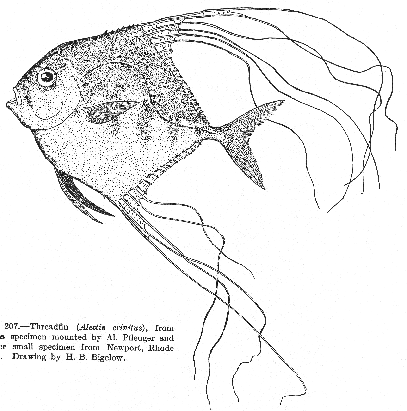Threadfin Alectis crinitus (Mitchill) 1826 [81]
[Jordan and Evermann, 1896-1900, p. 931, as Alectis ciliaris (Bloch 1788).]

Figure 207.—Threadfin (Alectis crinitus), from Florida specimen mounted by Al Pfleuger and another small specimen from Newport, Rhode Island. Drawing by H. B. Bigelow.
Description—
The combination of a head strongly convex in dorsal profile, with the fact that the first few rays of its soft dorsal fin, and of its anal fin also, are extremely long, and threadlike, places the threadfin at a glance among the carangoids of our northeastern coast. On small fish these threadlike rays are considerably longer than trunk and tail combined, but they shorten with age, probably to be entirely lost. The trunk of the threadfin is nearly as high as it is long (to the caudal peduncle), the dorsal profile of its head is strongly convex and it is strongly flattened sidewise. It has one dorsal fin of 1 stiff ray and about 19 soft rays, preceded by 6 short, separate, inconspicuous spines; the anal has 1 stiff ray and 16 soft rays, and is preceded by 2 spines so short that they are likely to be overlooked. Its lateral line is strongly arched over the pectoral; and the rear part armed with a series of bony platelike scales; the tail fin is deeply forked and the ventrals are larger than in most other carangoids. The pectorals are about as long as the head.
Color—
Upper surface bluish, the sides silvery, with traces of darker bars and blotches that tend to disappear with age; the prolonged parts of the dorsal and anal fins are bluish black; ventral fins mostly black; the fins otherwise more or less yellowish.
Size—
Specimens with the long threadlike fin rays have been reported up to about 7 inches long, in West Indian and Atlantic United States waters. But it now seems very probable that these are the young of the Cuban Jack (Hynnis cubensis Poey 1860). Their transformation consists chiefly in losing the filamentous fin rays; in a decrease in the depth of the body relative to its length; in a very considerable decrease in the relative size of the ventral fins; and in the assumption of a more falcate shape by the pectorals.
General range—
The threadfin (or threadfin stage of the Cuban Jack), is known on both coasts of tropical America; it strays northward on the Atlantic coast to southern Massachusetts, and it has been reported once from the Gulf of Maine. The adult Cuban Jack has not been reported north of southern Florida.[82]
[page 382]Occurrence in the Gulf of Maine—
The only records of this tropical fish for the Gulf of Maine are of one about 31/4 inches (85 mm.) long taken in a trap at Sagamore, on the southern shore of Cape Cod Bay, September 1, 1937, and another taken in a trap at North Truro, Mass., August 16, 1951. They may have come through the Cape Cod Canal as suggested by Smith.[83]
[81] We follow Smith (Copeia, 1938, p. 146) in using the name crinitus Mitchill 1826, proposed for a specimen taken near Block Island, R. I., rather than ciliaris Bloch 1788 (type locality East Indies), awaiting final decision as to the true relationship between the threadfins of different oceans.
[82] We have seen one taken at Key West, and there is one from the east coast of Florida in the Museum of Comparative Zoology.
[83] Copeia, 1938, p. 146.